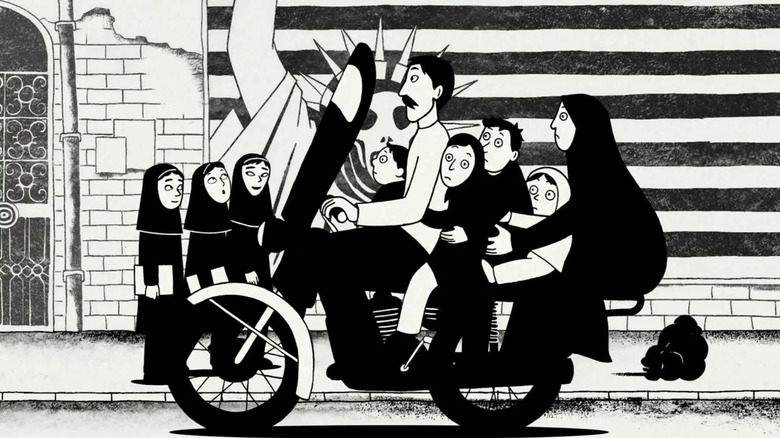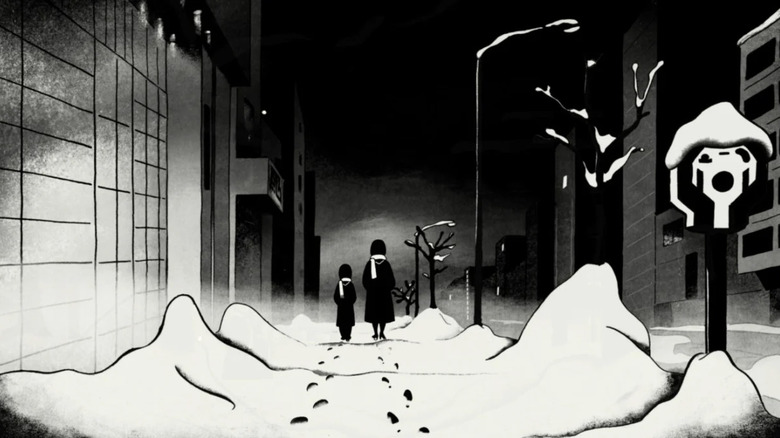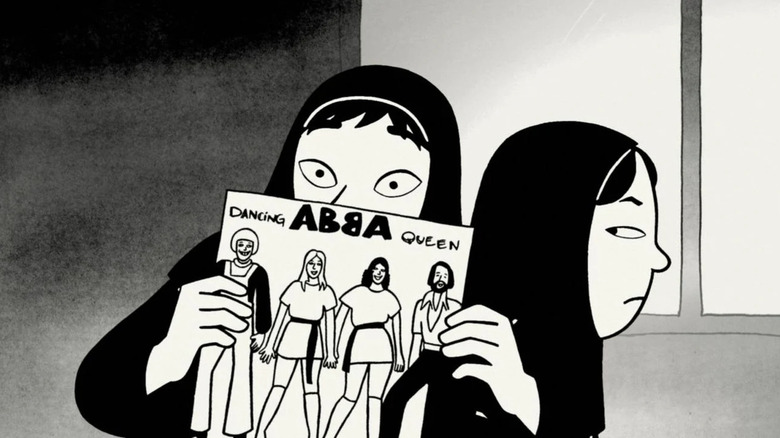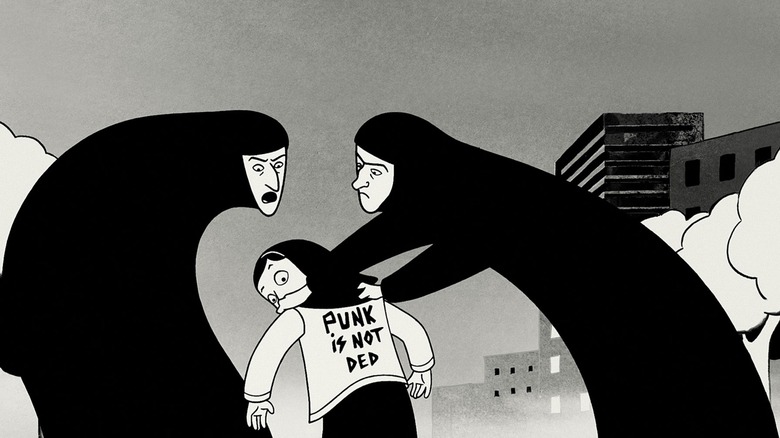Persepolis Uses Animation To Tell A Coming-Of-Age Story In The Midst Of Iranian Revolution
(Welcome to Animation Celebration, a recurring feature where we explore the limitless possibilities of animation as a medium. In this edition: "Persepolis.")
I was a sophomore in college taking my first Women's Literature class when I was first introduced to Marjane Satrapi's autobiographical graphic novel, "Persepolis." My professor was an adventurous woman who was clearly tired of rehashing Emily Brontë and Jane Austen year after year and wanted to try something new with our class. In addition to the so-called classics, she gave us the graphic novel "Fun Home" by Alison Bechdel (of The Bechdel Test fame) and "Persepolis." I distinctly remember one of my classmates scoffing at the book, dismissing graphic novels as "glorified picture books" and refusing to read the material. My professor had zero patience for someone disparaging the good word of graphic novels and held up "Persepolis" in her hand like a televangelist with a bible.
"This story and the 'glorified pictures' inside it contain more heartbreak, power, beauty, and character than half of this damn syllabus. I challenge you to read this and not be moved." That classmate ended up dropping the class, in case you were curious. I read all 160 pages of "Persepolis" in one sitting, becoming increasingly obsessed with Satrapi's incredible autobiography. Imagine my delight when I found out that the story had been given a film adaptation.
Directed by Satrapi and Vincent Paronnaud, "Persepolis" is the animated adaptation of the graphic novel and is presented in an almost identical animation style to the original illustrations. The film centers on Satrapi's evolution from childhood, to her rebellious, punk-loving teen years in the midst of the Iranian Revolution and later during the oppressive aftermath ruled by Islamic fundamentalists. The film was nominated for "Best Animated Feature" at the 2007 Academy Awards and remains one of the best mature animated features ever made.
The beauty of black and white
The story of "Persepolis" is ripe for a live-action coming-of-age drama, but Marjane Satrapi wisely made the decision to tell the story in animation, emulating the black and white drawings of her graphic novel. The film is presented almost exclusively in black and white, but incorporates sporadic uses of color whenever the action skips ahead to the present day. As the film is autobiographical, it is presented predominantly through Satrapi's flashbacks. The traditional hand-drawn cell animation highlights the scrappy energy of the outspoken teenage "Marji," and by using felt pens to draw the animation, there's a lived-in texture of the monochromatic style, which still appears vibrant despite the limitations in color use.
Keeping the film in black and white also strips away many of the desert stereotypes of the Iranian country from global viewers. The landscapes, notable buildings, and historical landmarks are presented indirectly, which allows the story to resonate with anyone, regardless of geographical location. For a story that is so deeply rooted in its characters, the animated styling allows for stronger control of the audience's interpretation of the material. It's a lot harder to disconnect from the world of "Persepolis" when the setting often looks like it could be anywhere.
The black and white coloring also emphasizes the film's thematic core, echoing the aesthetics and light theory of German expressionism but through animation. Marji is occasionally enveloped by blackness, the background consuming her black hair and black clothing, giving the appearance of existing in a void of nothingness. Few films have been able to capture feelings of loneliness, grief, isolation, or oppression quite as effectively.
A coming-of-age hero
Throughout "Persepolis," it's difficult not to find teenage Marjane Satrapi both wholly relatable, like the best friend we wish we could have had growing up. She gets in trouble with her teachers, plays music too loud, and isf fascinated by punk rock counter-culture. Satrapi comes from a progressive family, which makes them a target when the outcome of the war leads to living under the rule of the oppressive Islamic government. Her family is forced to endure the most extreme tragedies possible, and yet "Persepolis" still manages to maintain a playful sense of irony throughout it all. The anger characters express is justified, but the film itself never feels angry. It's like there's a permanent cloud of "Are you seeing this s***?" hovering over each frame. There's a perfect balance of the mourning Satrapi experiences as her homeland is rendered into something unrecognizable, and the sardonic humor that comes with coping.
As the film explores both Satrapi's childhood and teen years, it's astonishing how well she is able to capture the very different ways people interpret the world at different ages. While all of her characters, including herself, are showcased in 2D animation, everyone is a fully realized, multidimensional exploration of what it means to be human. "Persepolis" fluctuates between flashbacks and the present-day with ease, but never sacrifices the emotional center of the story. Even when the film's animation makes intentional choices to present a moment through a stylistic lens (like absurdism, for example), "Persepolis" constantly feels right at home in the world Satrapi created.
But make no mistake, for all of its quirks and witty wordplay, "Persepolis" is a deeply emotional film.
A vital viewing for Western audiences
Despite its foundational political relevance and important historical contributions, "Persepolis" is still a first-hand account of the life of Marjane Satrapi, an outspoken teen girl who loves Michael Jackson music and Bruce Lee movies, who just so happens to be living through a political revolution. She's an unreliable narrator and she makes reckless and inconsiderate decisions, but because of where she's growing up, she doesn't have the luxury of being a typical teen. No, the stakes are high, and often deadly, which means the repercussions of Marji's rebellious teen angst are far greater than the traditional forms of parental discipline.
An unfortunate reality is that the Western world has a stranglehold on popular culture around the globe, and therefore, the perspective of films that are easily accessible to American audiences is often hailed as the standard. "Persepolis" is, above all else, a gripping look into a world that most people fundamentally do not understand. For those who grew up in post-9/11 America, it's undeniable that there are some implicit biases we all must unlearn about Iran, and plenty to learn about our involvement in creating the current situation. "Persepolis" isn't just a stunning coming-of-age story about a feisty gal in Iran, it's also a foundational work in helping a majority of Western audiences better understand a culture that is often demonized by our own xenophobic media.



